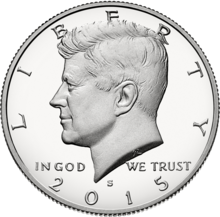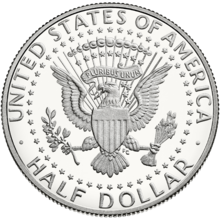Kennedy Half Dollar
| United States | |
| Value | 50 cents (.50 US dollar) |
|---|---|
| Mass |
Copper-nickel clad: 11.34 g |
| Diameter | 30.6 mm |
| Thickness | 2.15 mm |
| Edge | reeded |
| Composition |
|
| Gold | (2014 commemorative) .75 troy oz |
| Silver | Circulation strikes since 1971 contain no silver. For 90% silver issues: 0.36169 troy ounces. For 40% silver issues: 0.1479 troy oz |
| Years of minting | 1964–present |
| Mint marks | P, D, S, W. Located beneath where the eagle's claws grasp the olive branch on reverse for 1964 coins and for 1964-2014-W gold issue; above the date on the obverse for all other issues beginning in 1968. Mint mark omitted on all coins from 1965 to 1967 and on Philadelphia Mint issues before 1980. "W" mint mark only on 2014 commemorative issue. |
| Obverse | |
 |
|
| Design | Left profile of John F. Kennedy |
| Designer | Gilroy Roberts |
| Design date | 1964 to present |
| Reverse | |
 |
|
| Design | Modified presidential seal |
| Designer | Frank Gasparro |
| Design date | 1964 to present, excepting 1975 and 1976 |
 |
|
| Design | Independence Hall |
| Designer | Seth G. Huntington |
| Design date | 1975 and 1976 (dated 1776–1976) |
Copper-nickel clad: 11.34 g
40% silver clad: 11.50 g
90% silver: 12.50 g
The Kennedy half dollar, first minted in 1964, is a fifty-cent coin currently issued by the United States Mint. Intended as a memorial to the assassinated President John F. Kennedy, it was authorized by Congress just over a month after his death. Use of existing works by Mint sculptors Gilroy Roberts and Frank Gasparro allowed dies to be prepared quickly, and striking of the new coins began in January 1964.
The silver coins were hoarded upon their release in March 1964 by collectors and those interested in a memento of the late president. Although the Mint greatly increased production, the denomination was seldom seen in circulation. Continued rises in the price of silver increased the hoarding—many early Kennedy half dollars have been melted for their silver. Starting with 1965-dated pieces, the percentage of fine silver was reduced from 90% to 40% (silver clad), but even with this change the coin saw little circulation.
In 1971, when silver was eliminated entirely from the coins and production increased, the series began to see improved, but still limited circulation. A special design for the reverse of the half dollar was issued for the United States Bicentennial and was struck in 1975 and 1976. In addition to business strikes, special collector coins were struck for the Bicentennial in silver clad; silver proof sets in which the dime, quarter and half dollar were struck in 90% silver were first minted in 1992. In 2014 a special edition of the Kennedy half dollar was also struck in 99.99% gold.
Even though ample supplies of circulating half dollars are readily available from most banks, their circulation is still limited. Since 2002, Kennedy half dollars have only been struck to satisfy the demand from collectors, and are available at a premium through the Mint.
Within hours of the assassination of John F. Kennedy on November 22, 1963, Mint Director Eva Adams called Chief Engraver Gilroy Roberts, informing him that serious consideration was already being given to depicting Kennedy on one of the larger silver coins: either the silver dollar, half dollar, or quarter dollar. Adams called Roberts again on November 27 and authorized the project, stating that the late president's widow, Jacqueline Kennedy preferred that he be depicted on the half dollar, replacing the previous design of Benjamin Franklin. Mrs. Kennedy's reasoning was that she did not want to replace George Washington on the quarter.
...
Wikipedia
